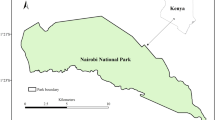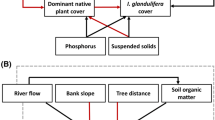Abstract
Exotic plants are generally considered a serious problem in wildlands around the globe. However, some argue that the impacts of exotic plants have been exaggerated and that biodiversity and other important plant community characteristics are commonly improved with invasion. Thus, disagreement exists among ecologists as to the relationship of exotic plants with biodiversity and native plant communities. A better understanding of the relationships between exotic plants and native plant communities is needed to improve funding allocation and legislation regarding exotic plants, and justify and prioritize invasion management. To evaluate these relationships, 65 shrub–bunchgrass plant communities with varying densities of an exotic annual grass, Taeniatherum caput-medusae (L.) Nevski (medusahead), were sampled across 160,000 ha in southeastern Oregon, United States. Environmental factors were generally not correlated with plant community characteristics when exotic annual grass density was included in models. Plant diversity and species richness were negatively correlated with exotic annual grass density. Exotic annual grass density explained 62% of the variation in plant diversity. All native plant functional groups, except annual forbs, exhibited a negative relationship with T. caput-medusae. The results of this study suggest that T. caput-medusae invasions probably have substantial negative impacts on biodiversity and native plant communities. The strength of the relationships between plant community characteristics and T. caput-medusae density suggests that some exotic plants are a major force of change in plant communities and subsequently threaten ecosystem functions and processes. However, experimental studies are needed to fully substantiate that annual grass invasion is the cause of these observed correlations.




Similar content being viewed by others
References
Adams SN, Engelhardt KAM (2009) Diversity declines in Microstegium vimineum (Japanese stiltgrass) patches. Biol Conserv 142:1003–1010
Aldridge CL, Nielsen SE, Beyer HL, Boyce MS, Connelly JW, Knick ST, Schroeder MA (2008) Range-wide patterns of greater sage-grouse persistence. Divers Distrib 14:983–994
Anderson EW, Borman MM, Krueger WC (1998) The ecological provinces of Oregon: a treatise on the basic ecological geography of the state. Oregon Agricultural Experiment Station, Corvallis, OR
Belnap J (2003) Biological soil crusts in deserts: a short review of their role in soil fertility, stabilization, and water relations. Arch Hydrobiol 19:113–126
Belnap J, Phillips SL (2001) Soil biota in an ungrazed grassland: response to annual grass (Bromus tectorum) invasion. Ecol Appl 11:1261–1275
Box GEP, Hunter JS, Hunter WG (2005) Statistics for experimenters: design, innovation, and discovery, 2nd edn. Wiley, Hoboken, NJ
Brewer S (2008) Declines in plant species richness and endemic plant species in longleaf pine savannas invaded by Imperata cylindrica. Biol Invasions 10:1257–1264
Brooks ML, D’Antonio CM, Richardson DM, Grace JB, Keeley J, DiTomaso JM, Hobbs RJ, Pellant M, Pyke D (2004) Effect of invasive alien plants on fire regimes. Bioscience 54:677–688
Canfield RH (1941) Application of the line interception methods in sampling range vegetation. J For 39:388–394
Connelly JW, Braun CE (1997) Long-term changes in sage grouse Centrocercus urophasianus populations in western North America. Wildl Biol 3:229–234
Connelly JW, Schroeder MA, Sands AR, Braun CE (2000) Guidelines to manage sage grouse populations and their habitats. Wildl Soc Bull 28:967–985
Cronk CB, Fuller JL (1995) Plant invaders: the threat to natural ecosystems. Chapman and Hall, New York
CS NR (1998) Precipitation maps. National Cartography & Geospatial Center, Fort Worth
D’Antonio CM, Vitousek PM (1992) Biological invasions by exotic grasses, the grass/fire cycle, and global change. Annu Rev Ecol Syst 23:63–87
D′Antonio C, Meyerson LA (2002) Exotic plant species as problems and solutions in ecological restoration: a synthesis. Restor Ecol 10:703–713
Davies KW (2008) Medusahead dispersal and establishment in sagebrush steppe plant communities. Range Ecol Manag 61:110–115
Davies KW, Bates JD (2010) Vegetation characteristics of mountain and Wyoming big sagebrush plant communities in the northern Great Basin. Range Ecol Manag 63:461–466
Davies KW, Johnson DD (2008) Managing medusahead in the Intermountain West is at a critical threshold. Rangelands 30:13–15
Davies KW, Sheley RL (2011) Promoting native vegetation and diversity in exotic annual grass infestations. Restor Ecol 19:159–165
Davies KW, Svejcar TJ (2008) Comparison of medusahead invaded and non-invaded Wyoming big sagebrush steppe in southeastern Oregon. Range Ecol Manag 61:623–629
Davies KW, Bates JD, Miller RF (2006) Vegetation characteristics across part of the Wyoming big sagebrush alliance. Range Ecol Manag 59:567–575
DiTomaso JM (2000) Invasive weeds in rangelands: species, impacts, and management. Weed Sci 48:255–265
Flory SL, Clay K (2010) Non-native grass invasion alters native plant composition in experimental communities. Biol Invasions 12:1285–1294
Gaertner M, Breeyen AD, Hui C, Richardson DM (2009) Impacts of alien plant invasions on species richness in Mediterranean-type ecosystems: a meta analysis. Prog Phys Geogr 33:319–338
Gee GW, Bauder JW (1986) Particle-size analysis. In: Klute A (ed) Methods of soil analysis, part 1. Physical and mineralogical methods. American Society of Agronomy and Soil Science Society of America, Madison, pp 383–411
Gerber E, Krebs C, Murrell C, Moretti M, Rocklin R, Schaffner U (2008) Exotic invasive knotweeds (Fallopia spp.) negatively affect native plant and invertebrate assemblages in European riparian habitats. Biol Conserv 141:646–654
Harniss RO, Murray RB (1973) 30 years of vegetal change following burning of sagebrush-grass range. J Range Manag 26:322–325
Hironaka M (1994) Medusahead: natural successor to the cheatgrass type in the northern Great Basin. p 89–91. In: Monsen SB, Kitchen SG (comps.) Proceedings—ecology and management of annual rangelands. Boise, ID. May 18–21, 1992. United States Department of Agriculture, Forest Service, Intermountain Research Station. General Technical Report INT-GTR-313. Ogden, UT
Hironaka M, Sindelar BW (1975) Growth characteristics of squirreltail seedlings in competition with medusahead. J Range Manag 28:283–285
Hobbs RJ, Atkins L (1988) Effect of disturbance and nutrient addition on communities in the Western Australian wheatbelt. Aust J Ecol 13:171–179
Hobbs RJ, Atkins L (1990) Fire related dynamics of a Banksia woodland in south-western Australia. Aust J Bot 38:97–110
Hooper DU, Vitousek PM (1998) Effects of plant composition and diversity on nutrient cycling. Ecol Monogr 68:121–149
Hughes F, Vitousek PM, Tunison T (1991) Alien grass invasion and fire in the seasonal submontane zone of Hawaii. Ecology 72:743–746
Humphrey LD (1984) Patterns and mechanisms of plant succession after fire on Artemisia-grass sites in southeastern Idaho. Vegetatio 57:91–101
James JJ, Davies KW, Sheley RL, Aanderud ZT (2008) Linking nitrogen partitioning and species abundance to invasion resistance in the Great Basin. Oecologia 156:637–648
Krebs CJ (1998) Ecological methodology, 2nd edn. Benjamin Cummings, Menlo Park, CA
Lacey JR, Olson BE (1991) Economic and resource impacts of noxious range weeds. In: James LF, Evans JO, Ralphs MH, Child RD (eds) Noxious range weeds. Westview Press, Boulder, pp 5–16
Lauenroth WK, Dodd JL, Sims PL (1978) The effects of water- and nitrogen-induced stresses on plant community structure in a semiarid grassland. Oecologia 36:211–222
Lepš J (2004) What do the biodiversity experiments tell us about consequences of plant species loss in the real world? Basic Appl Ecol 5:529–534
Levine JM (2000) Species diversity and biological invasions: relating local processes to community patterns. Science 288:852–854
Liu J, Dong M, Miao SL, Li ZY, Song MH, Wang RQ (2006) Invasive alien plants in China: role of clonality and geographical origin. Biol Invasions 8:1461–1470
Mack RN (1981) Invasion of Bromus tectorum L. into western North America: an ecological chronicle. Agro-Ecosystems 7:145–165
Mack RN, Simberloff D, Lonsdale WM, Evans H, Clout M, Bazzaz FA (2000) Biotic invasions: causes, epidemiology, global consequences, and control. Ecol Appl 10:689–710
Maron J, Marler M (2007) Native plant diversity resists invasion at both low and high resource levels. Ecology 88:2651–2661
Maron JL, Marler M (2008) Field-based competitive impacts between invaders and natives at varying resource supply. J Ecol 96:1187–1197
Masters RA, Sheley RL (2001) Principles and practices for managing rangeland invasive plants. J Range Manag 54:502–517
Meffin R, Miller AL, Hulme PE, Duncan RP (2010) Experimental introduction of the alien plant Hieracium lepidulum reveals no significant impact on montane plant communities in New Zealand. Divers Distrib 16:804–815
Milton S (2004) Grasses as invasive alien plants in South Africa. S Afr J Sci 100:69–75
Moroń D, Lenda M, Skórka P, Szentgyörgyi H, Settele J, Woyciechowski M (2009) Wind pollinator communities are negatively affected by invasion of alien goldenrods in grassland landscapes. Biol Conserv 142:1322–1332
Naeem S, Knops JMH, Tilman D, Howe KM, Kennedy T, Gale S (2000) Plant diversity increases resistance to invasion in the absence of covarying extrinsic factors. Oikos 91:97–108
Olson BE (1999) Impacts of noxious weeds on ecologic and economic systems. In: Sheley RL, Petroff JK (eds) Biology and management of noxious rangeland weeds. Oregon State University Press, Corvallis, pp 4–18
Oregon Climatic Service (2009) URL: http://www.ocs.oregonstate.edu/index.html. Accessed 1 Sept 2009
Pawson SM, McCarthy JK, Ledgard NJ, Didham RK (2010) Density-dependent impacts of exotic conifer invasion on grassland invertebrate assemblages. J Appl Ecol 47:1053–1062
Ponzetti JM, McCune BP (2001) Biotic soil crusts of Oregon’s shrub steppe: community composition in relation to soil chemistry, climate, and livestock activity. Bryologist 104:212–225
Purdie RW, Slatyer RO (1976) Vegetation succession after fire in sclerophyll woodland communities in south-eastern Australia. Aust J Ecol 1:223–236
Sagoff M (2005) Do non-native species threaten the natural environment? J Agric Environ Ethics 18:215–236
Sax DF, Gaines SD (2003) Species diversity: from global decreases to local increases. Trends Ecol Evol 18:561–566
Simberloff D (2005) Non-native species do threaten the natural environment. J Agric Environ Ethics 18:595–607
Tilman D (1999) The ecological consequences of changes in biodiversity: a search for general principles. Ecology 80:1455–1474
Tilman D, Lehman CL, Thomson KT (1997) Plant diversity and ecosystem productivity: theoretical considerations. Proc Natl Acad Sci USA 94:1857–1861
Torell PJ, Erickson LC, Haas RH (1961) The medusahead problem in Idaho. Weeds 9:124–131
Wallestad R, Peterson JG, Eng RL (1975) Foods of adult sage grouse in central Montana. J Wildl Manag 39:628–630
Wambolt CL, Walhof KS, Frisina MR (2001) Recovery of big sagebrush communities after burning in south-western Montana. J Environ Manag 61:243–252
Whisenant SG (1990) Changing fire frequencies on Idaho’s Snake River Plains: ecological and management implications. In: McArthur ED, Romney EM, Smith SD, Tueller PT (eds) Cheatgrass invasion, shrub die-off, and other aspects of shrub biology and management(comps). Las Vegas, Nevada, pp 4–10
Young JA (1992) Ecology and management of medusahead (Taeniatherum caput-medusae ssp. asperum [SIMK.] Melderis). Great Basin Nat 52:245–252
Young K, Mangold J (2008) Medusahead outperforms squirreltail through interference and growth rate. Invasive Plant Sci Manag 1:73–81
Acknowledgments
The author appreciated Dr. Bruce Mackey’s (Area Statistician) assistance with the statistical analyses. Data collection by Shawna Lang, Matthew Coffman, Josh Monson, Eric Hough, Julie Garner, Tate Walters, Elaine Cramer, Carrie Cimo, Ryan Morgan, Jen Trenary, and Aleta Nafus was greatly appreciated. The author also thanks the Burns and Vale Bureau of Land Management for allowing this research project to occur on lands they administer. Reviews of the manuscript by Jeremy James, Matt Rinella, Chad Boyd, Dustin Johnson, and Derek Allen were greatly appreciated. Thoughtful reviews and constructive criticisms by Dr. Bryan Foster and anonymous reviewers were greatly valued. The Eastern Oregon Agricultural Research Center is jointly funded by the USDA-Agricultural Research Service and Oregon State University. These experiments comply with the current laws of the country in which they were performed.
Author information
Authors and Affiliations
Corresponding author
Additional information
Communicated by Bryan Foster.
Mention of a proprietary product does not constitute a guarantee or warranty of the product by United States Department of Agriculture, Oregon State University, or the author, and does not imply its approval to the exclusion of other products.
Rights and permissions
About this article
Cite this article
Davies, K.W. Plant community diversity and native plant abundance decline with increasing abundance of an exotic annual grass. Oecologia 167, 481–491 (2011). https://doi.org/10.1007/s00442-011-1992-2
Received:
Accepted:
Published:
Issue Date:
DOI: https://doi.org/10.1007/s00442-011-1992-2




